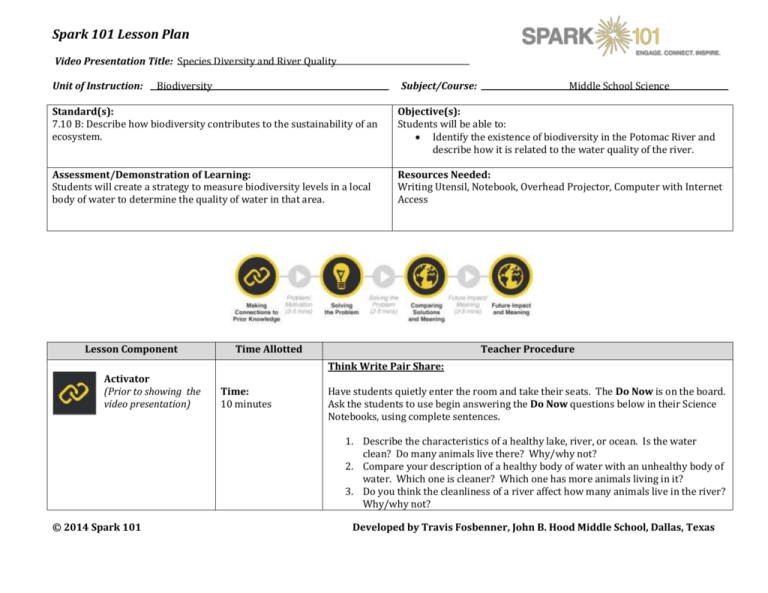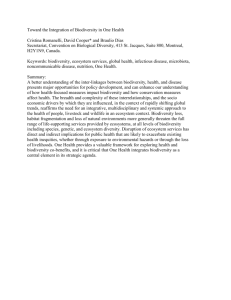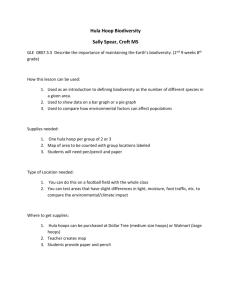Spark 101 Species Diversity MS Science Lesson Plan
advertisement

Spark 101 Lesson Plan Video Presentation Title: Species Diversity and River Quality Unit of Instruction: Biodiversity Subject/Course: Middle School Science Standard(s): 7.10 B: Describe how biodiversity contributes to the sustainability of an ecosystem. Objective(s): Students will be able to: Identify the existence of biodiversity in the Potomac River and describe how it is related to the water quality of the river. Assessment/Demonstration of Learning: Students will create a strategy to measure biodiversity levels in a local body of water to determine the quality of water in that area. Resources Needed: Writing Utensil, Notebook, Overhead Projector, Computer with Internet Access Lesson Component Activator (Prior to showing the video presentation) Time Allotted Teacher Procedure Think Write Pair Share: Time: 10 minutes Have students quietly enter the room and take their seats. The Do Now is on the board. Ask the students to use begin answering the Do Now questions below in their Science Notebooks, using complete sentences. 1. Describe the characteristics of a healthy lake, river, or ocean. Is the water clean? Do many animals live there? Why/why not? 2. Compare your description of a healthy body of water with an unhealthy body of water. Which one is cleaner? Which one has more animals living in it? 3. Do you think the cleanliness of a river affect how many animals live in the river? Why/why not? © 2014 Spark 101 Developed by Travis Fosbenner, John B. Hood Middle School, Dallas, Texas 4. Can you think of any other habitats where the number of animals tells you how healthy the environment is? Have the students complete the answers silently. After the students have written their answers, instruct them to share with a seat partner at a quiet volume level. Next, take about 2 answers from individuals in the class. Problem/Motivation (Part I of video) Time: 9 minutes Show this first segment of the video to your students, letting them know that they will be working on solving the real-world problem after viewing. Ask students to take notes during the video, answering the following questions by writing them down: 1. If the group catches a larger number (diverse) of species, what does the mean about the river quality? 2. What does an indicator species tell you about a body of water? 3. How do the students determine how many species live in the river? Problem Solving Activity (Describe process for identifying possible solution(s) to the problem presented) Time: 15 minutes Grouping: Independent Pairs Small groups (3-5) Whole group Go over answers with the entire group. Have students divide into groups of 3-4. Around the room, the following questions will be posted (one at each station). Have the student groups walk around the room with their notebooks. Give them about 2 minutes at each question. Students should discuss the answer and then write down their answer in their notebook. The man in the video used the word ‘biodiversity’. What does ‘biodiversity’ mean and how is it related to the video that we just watched? How does the group of students identify different species from each other? Do you think there were many species in the river? Why/why not? Given what we saw, do you think the Potomac River is healthy or unhealthy? Explain why you think that. How could humans make the river healthier? Checks for Understanding Once the students are done going around the room, have them sit back down and go over the answers with them. Solving the Problem (Part II of video) © 2014 Spark 101 Time: 4 minutes Show this second segment of the video to your students, letting them know that they will be comparing their solutions to the actual solution shared by the industry professional(s). Developed by Travis Fosbenner, John B. Hood Middle School, Dallas, Texas As students watch the second part of the video, have them silently answer the following questions: Did the scientists come to the same conclusions as you did about the biodiversity in the river? Which indicator species were found in the river? What did they indicate? Why did the river not receive an “A” score? Answer the questions with the whole group. The Scientific Method Comparing Solutions and Meaning (Describe process for identifying possible solution(s) to the problem presented) Time: 8 minutes Grouping: Independent Pairs Small groups (3-5) Whole group Utilize The Scientific Method Template for this task. Arrange students in groups of 3-4. Groups are tasked with creating a study to measure the biodiversity of the river that would be more accurate than the one we saw in the video. Students should use the following questions to guide their thinking: Did the scientists in the video sample the river from one location or many locations? Did the scientists in the video sample the river on just one day or did they go back many different days to get many different samples? How could increasing the frequency of river samples make this study more accurate? Have students use their answers from above to guide them in creating a study that would result in more accurate findings about the water quality of the Potomac River. Checks for Understanding Walk around the room and check in on the progress of every group. Be sure that everyone is on track to recognize that increasing the size of the study would make its findings more accurate. Future Impact and Meaning (Part III of video) © 2014 Spark 101 Time: 2 minutes Show this third and final segment of the video to your students, letting them know that they will be reflecting on their thoughts related to pursing possible education pathways and careers presented in the video. Developed by Travis Fosbenner, John B. Hood Middle School, Dallas, Texas Value-Based Problem Solving Future Impact and Meaning (Have students reflect on how solving the problem might relate to current or future goals) Time: 7 minutes Grouping: Independent Pairs Small groups (3-5) Whole group Utilize the value-based problem solving template for this activity. Have the students relate what they learned in the video to a local body of water that they are more familiar with. Ask each student to write down a body of water (lake, stream, river) that they have visited in the past. Have each student write a basic plan describing how he/she would go about testing the water quality of his/her body of water using the concept of biodiversity. Ask the students to answer the following questions when creating their plans: How will they measure the amount of biodiversity found in the body of water? How will they identify the different species that are found in the body of water? What will their findings tell them about the water quality of the area? How could they improve the water quality of the area? Checks for Understanding This will be the Exit Ticket (which will be graded privately by the teacher). Reflective Journals Summarizer/Closure Time: 6 minutes If time allows, move on to another video. While watching this video about the White Rock Lake, ask students to write the different species (both in water and out of the water) that they see in the video and use that information to determine if the water quality is healthy/unhealthy. https://www.youtube.com/watch?v=29057XelXBM Assessment (if applicable) Additional Notes (if needed) CK12 Connections (if available) OpenStax Connections (if available) Free videos, activities, problems, and background text available at: http://www.ck12.org/earth-science/Water-Pollution/ © 2014 Spark 101 Developed by Travis Fosbenner, John B. Hood Middle School, Dallas, Texas






